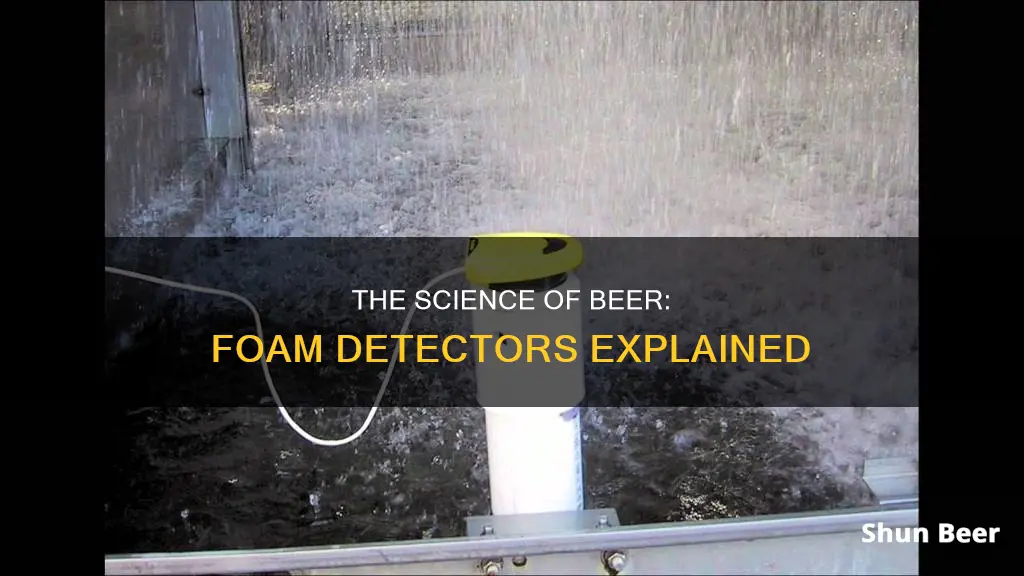
A foam-on-beer detector, or FOB, is a device used in commercial and residential draft beer systems to reduce waste and increase profits. When installed on a long-draw beer line, a FOB detector can sense when a keg is empty and will immediately stop the flow of beer, preventing foam from entering the line. This allows the line to remain full of beer, eliminating the need to refill and purge the system when tapping a new keg, ultimately reducing waste and increasing cost efficiency.
| Characteristics | Values |
|---|---|
| Purpose | Reduce beer waste and increase profits |
| Function | Stops beer flow when a keg is empty |
| Beer Flow | Forces the float inside the FOB into the "up" position, allowing beer to flow to the faucet |
| Empty Keg | Float drops down, stopping the beer flow from the keg |
| New Keg | Push the vent mechanism to release gas and foam from the chamber, allowing beer to flow from the keg into the chamber |
| Cleaning | Regular cleaning required; FOBs are equipped with a float-lifting device to allow cleaning fluids to enter and exit the detector |
What You'll Learn

Beer flow mechanics
The mechanics of beer flow are important to understand when considering how a foam-on-beer detector works. Beer is often moved around breweries in pipes, so an understanding of flow rates and turbulence is essential. The rate of flow of a fluid is typically measured using flow meters. The speed of a fluid moving through a pipe is influenced by several factors. Firstly, due to friction with the pipe walls, fluid near the walls moves more slowly, while fluid in the middle of the pipe moves faster. This difference in velocity can cause turbulence as the layers of liquid moving at different speeds interact. The viscosity of the liquid and the diameter of the pipe also affect turbulence; more viscous liquids and narrower pipes increase friction and turbulence.
Turbulence is undesirable when transferring carbonated beer as it causes foaming. Therefore, when designing a beer flow system, it is important to consider the factors that influence flow rate and turbulence to minimise waste and maximise profits. This is where foam-on-beer detectors (FOBs) come into play. FOBs are installed in long-draw draft beer systems to reduce beer waste and increase profits. When a keg empties, the beer flow is stopped immediately by the FOB, which uses a float to detect the presence of beer. This prevents the beer line from filling with foam and keeps the line full of beer, eliminating the need to refill and purge the system when a new keg is tapped. By understanding the mechanics of beer flow and utilising FOBs, establishments can improve the efficiency and profitability of their beer dispensing systems.
Beer Bar Memberships: Are They Worth the Cost?
You may want to see also

Float mechanics
The mechanics of the float in a foam-on-beer detector (FOB) are relatively simple. When beer flows from the keg, it forces the float inside the FOB into the "up" position, which allows the beer to flow to the faucet. When the keg empties, the float drops down, stopping the beer flow from the keg. This prevents the line from filling with foam and keeps the line full of beer instead.
When a new keg is tapped, the FOB must be reset by pushing the vent mechanism, which releases gas and foam from the chamber. This allows beer to flow from the keg into the chamber, lifting the float and enabling beer to flow to the faucet.
The FOB's float mechanism ensures that the beer line remains full of beer, eliminating the need to refill the lines and purge the system when a new keg is tapped. This significantly reduces beer waste and increases profits for establishments using long-draw draft beer systems.
Regular maintenance and cleaning of the FOB are crucial. FOBs are equipped with a float-lifting device that allows for the flow of cleaning fluids to enter and exit the detector during the cleaning process.
Beer Coolers: Understanding the Science of Cold
You may want to see also

Cleaning process
To clean a foam on beer (FOB) detector, the device must be regularly maintained and cleaned, just like beer lines. The Brewers Association and other sources recommend disassembling and cleaning the FOB every three months. This can be done by following these steps:
- Untap the keg with the line to the FOB.
- Connect the line to the cleaning canister or recirculating pump.
- Bleed the line so it is empty, including purging the FOB drain line.
- Disassemble and clean all internal parts of the FOB, using non-abrasive brushes to clean and wipe all internal surfaces.
- Run solution/water through the line.
- Purge the FOB and drain line while there is solution/water inside.
- Tap the keg and flush all remaining water in the line so there is only beer in the line.
It is important to use a beer line cleaner to remove organic waste buildup. However, this may not be effective at removing mineral deposits. Therefore, it is recommended to also use an acid beer line cleaner to eradicate beer stones and mineral accumulations. If a company is cleaning your beer lines, ensure they are cleaning both the lines and the FOBs.
Understanding Three-Burner Brewing: An Efficient Beer System
You may want to see also

Installation process
To install a foam-on-beer detector (FOB), follow these steps:
Firstly, FOBs are designed for long-draw draft beer systems, so ensure you have the appropriate setup. FOBs are compatible with CO2 and mixed-gas pressurised dispense systems.
Now, to the installation:
- Attach the beverage line from the outlet of the keg coupler to the straight inlet of the FOB.
- Attach the beverage line from the elbow outlet of the FOB to the faucet shank.
- Connect a fresh keg and push the purge button until the chamber fills with beer.
- Push the bottom knob in to lift the float, then pull it out for normal operation.
Note that FOBs must be regularly cleaned and maintained, just like beer lines. They are equipped with a float-lifting device to facilitate this. Under no circumstances should the FOB be bypassed during cleaning.
With these steps, you can install and maintain a FOB to reduce beer waste and increase profits.
Beer Breakdown: Understanding Its Effect on the Human Body
You may want to see also

Cost-effectiveness
Foam-on-beer detectors (FOBs) are an innovative way to save money and increase profits for bars and breweries. FOBs are an effective way to reduce beer wastage, which is a common issue when changing kegs. This is especially beneficial in long-draw systems, where the loss of beer for each keg emptied without a FOB can amount to tens of pints.
The cost-effectiveness of FOBs can be seen in the reduction of beer waste. When a FOB is installed on a long-draw beer line, it immediately stops the beer flow when the keg empties, preventing the line from filling with foam. This eliminates the need to refill the lines and purge the system with beer when tapping a new keg, resulting in significant beer savings. For example, an establishment without FOBs that dispenses 20 kegs per week through a 100-foot beer draw would waste approximately 46 12-oz glasses of beer, amounting to $46 of wasted profit per week. With FOBs, this waste is eliminated, and the system can pay for itself in as little as 6 kegs.
Additionally, FOBs help to maintain the pressure in beer lines, avoiding the loss of beer that occurs when changing kegs. This is crucial for bars and breweries that use beer pumps, as running them dry is the most common cause of pump failure. By keeping the lines full of beer, FOBs ensure that pumps have the necessary liquid to run effectively.
The use of FOBs also provides efficiency and cleanliness for bars, especially during busy service. Without FOBs, running out of draft beer can cause disruptions and waste, as beer foam spills all over the place. FOBs detect when a barrel has run empty and respond by stopping the beer flow before it reaches the tap, preventing foam build-up and keeping the beer lines full. This saves time and effort for bartenders, as they no longer need to detach and purge beer lines when changing kegs.
In summary, FOBs are a cost-effective solution for bars and breweries, reducing beer waste, maintaining pressure in beer lines, and providing efficiency during busy service. The savings in beer waste and improved efficiency can quickly offset the cost of installing FOBs, making them a valuable investment for any establishment serving draft beer.
Krups Beertender: Compatible With Other Beers?
You may want to see also
Frequently asked questions
A foam on beer detector (FOB) is a device used in commercial and residential draft beer systems to reduce product waste and increase profits.
When a keg empties, the FOB stops the flow of beer immediately. This prevents the beer line from filling with foam and keeps the line full of beer. When a new keg is tapped, beer can be poured immediately without needing to refill the line or purge the system.
Without a FOB, when a keg empties, the beer line fills with foam. This foam then needs to be purged from the system before a new keg can be tapped. This results in wasted beer and reduced profits.
FOBs are installed in conjunction with long-draw beer systems, which are typically used in bars and pubs with long beer lines.
FOBs should be cleaned regularly in the same way that beer lines are cleaned. FOBs are equipped with a float-lifting device that allows cleaning fluids to enter and exit the detector.







